Putting the pin in..
![]()

I was rebedding a pulpit the other day and the pins in the lifelines were put in the opposite of the above picture. I explained to the owner that I like to put them in as above as if the ring ding for some reason backs out and the boat is heeled the pin will either fall into the boat and you have a possibility of saving it from going overboard or it stays in place due to gravity. I really prefer lashing them on with spectra with the line going around the 1″ round. You are therefore not relying on the spot welds on the loops, there are no pins to go missing and if you have a man overboard you can knife the top lifeline to make it easier to get the MOB back onboard.
 I also had another pulpit that sheared so I to relead the bow light electrical as it was damaged and I couldn’t fish the end back out. I used fishing line and a pencil sinker pushing this into the hole in the pulpit and then jiggling it back and forth to get it around the twists and turns. Sounds easy but time consuming and frustrating.

CYC Midwinters
This video was not taken from our boat but it shows the fun that was had by all at the mark rounding in light air!
No wind but lots of activity!
This last weekend I raced on Astra in the CYC midwinters doing bow. There was a large ebb both days with less than 10 knots of wind for the start on saturday. Within .5 mile of the start we were anchored of Point Stewart. Half the fleet decided to leave Angel to port the next mark was Southampton Shoals. Boats that didn’t anchor vainly tried to overcome the growing ebb with less and less wind and it was time to get the fenders out to protect the boat from unwelcome visitors! Finally a wind line worked it’s way down Racoon Straits and we pulled up the anchor which had a fishing net complete with starfish and seaweed attached to the flukes. Guess that’s why it wasn’t holding that well! Off we went working the Marin shoreline tacking back and forth staying in shallow water to get out of the river of tide we looked like heros out in front of the fleet. Then the anchor went down again as we popped out of Raccoon straits and were getting pushed to Treasure.
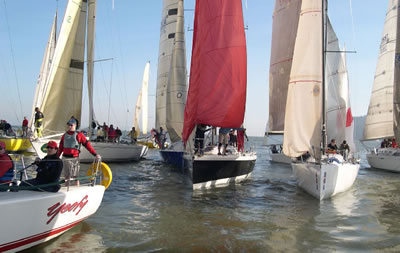 Â
Â
The fleet converged at the red number 10 bouy and there was lots of yelling, mayhem and fiberglass crunching. Astra got through unscathed as the boats behind cleared away to either side allowing the wind to fill the spinnaker while everyone else was blanketing each others spinnakers.
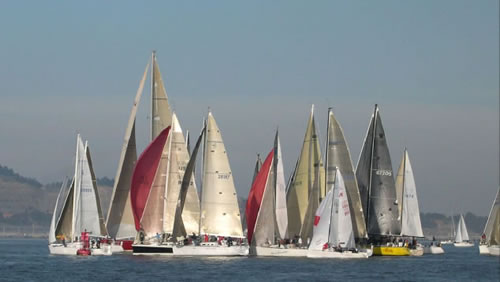
We reentered Racoon heading for the finish with almost 10 knots of breeze unfortunately in one of those last tacks one of the crew badly lacerated his head. While crossing under the boom by the vang his foot caught on the halyard and he head butted the turnbuckle on the new weather side creating two cuts one triangular shaped 1 1/2″ on each side and another straight laceration of 2″ long. There was a large amount of blood and pressure was applied with numerous guaze pads. We put his hat back on so that we could tape the pads to his head without sticking to his hair. He really did put on a brave face. Mary the owner and the crew member spent 3 hours in Marin Emergency room and 7 stitches later he was sent home with some pain killers.
 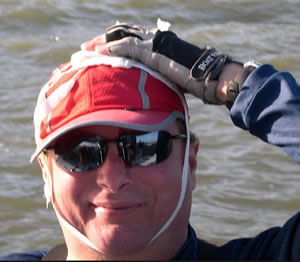
Due to some dredging near the enterance to SFYC there is an issue getting the boat into the harbour at the moment. The silting in didn’t even allow us to get to the guest dock on Friday. So we ended up boom riding to heel the boat over as much as possible both Saturday and Sunday to get into the dock after racing.
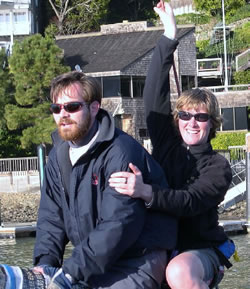
Sunday was a lot less exciting – just a standard day of racing ! The race was only an hour long as the wind was consistent.
Always round the corners!
I have been building a new boom for my brother’s moore 24 and also finishing off the mast which we bought from Buzz Ballenger. One of the important things to think about when making the holes in the mast for fittings is to make sure you use a file to round of the corners of any rectangular cuts made for sheaves. This is important whether it is a carbon mast or an aluminum mast. Last year we had the unfortunate situation of falling victim to a hole that was cut in the mast, the corners were not rounded off and the hole was oversized (at the time we were winning our class) we ended up retiring from the regatta due to the subsequent mast failure (see picture). N.B. The hole was not cut by the mast manufacturer but by someone after the rig had been delivered.

I use cardboard to create a template for the fitting that I am installing on the mast. I then trace the template onto the rig at the correct point, drill a large hole and then use a jigsaw to cut the section out. Next I take a file and make the hole the correct size for the fitting taking off a little at a time. Lastly I take a rat tail file and round of the corners. I take some electrical tape and use it as an insulator between the stainless and the aluminum by taping the plate and then using a razor to remove the excess tape. I use tefgel on the screws or rivets that hold the fitting in place to stop the electrolysis between the two different metals.
The French Invasion

This last weekend a group of us went on our annual ski trip to Tahoe which is always the 2nd weekend of February. We rent a large ski cabin owed by a school friend of mines family. It is a great cabin near Tahoe City that holds 10 people. A few people cancelled last minute so we ended up with only 6 up at the cabin. 4 out of the 6 are French so I had a good time trying out bad French and trying to understand them!
Scott was cross country skiing so he kindly took Draeger the dog out for some trail walks. I tried to stay up with the French on the slopes. My skiing is functional and not stylish at all – oh well for a person that goes once a year. IÂ stuck with them even on the double diamond black which I almost bailed on and started the long walk back on the catwalk then decided I was being old and did it anyways. Allez op was the call on the slopes all weekend.
The snow was amazing I have not ever seen it that deep in the last 8 years I have been going up there. It was spring skiing conditions – very warm sun but not slushy snow. We skied Homewood on Saturday with the beautiful views of the lake and Alpine on Sunday where we had a picnic at the top of the mountain. We made our skis into lounge chairs! A very enjoyable weekend.

Have a good week.
Rule 34 – Manoeuvring and warning signals
Print this out and tape it to your fog horn canister. Â
When in sight of one another, a power-driven vessel underway, when manoeuvring sounds the following (can be supplemented with all arond white light with visible range of 5 miles 1 second flashes with 1 second between and 2 seconds between signals)
– one short blast to mean “I am altering my course to starboard”.
– two short blasts to mean “I am altering my course to port”.
– three short blasts to mean “I am operating astern propulsion”.ÂIn sight of one another in a narrow channel or fairway when intending to overtake
– two prolonged blasts followed by one short blast to mean “I intend to overtake you on your starboard side”.
– two prolonged blasts followed by two short blasts to mean “I intend to overtake you on your port side”.To indicate agreement of being overtaken
– one prolonged, one short, one prolonged and one short blast, in that order.
– five short and rapid blasts on the whistle or light signal – fail to understand your intentions and are in doubt whether you are taking sufficient action to avoid collision,
– one prolonged blast vessel nearing a bend or an area of a channel or fairway where other vessels may be obscured and response if you hear it and don’t see the vessel
Messenger Line Tangles?
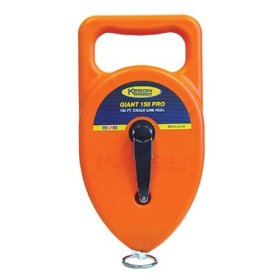
After spending way too much time untangling messenger line I decided what was needed was a cassette that would house the line and allow me to go up the mast and drop a tag line down inside the rig easily. The result was a search for industrial chalk lines that took me to Amazon.com where I buy Keson G150 Giant Chalk boxes. The cassettes will hold up to 150 feet of tagline. What I do is remove the chalk line and replace it with dacron tagline from Svends. I then go to the local bike shop and get some used bike chain. I cut sections about 8 inches long and I can tie this to the tagline. To stop the bike chain from wrapping around spreader bars in the rig take some electrical shrink wrap and shrink wrap the bike chain. The result is a long thin weight that will allow you to swiftly drop a new tagline into the rig from the masthead. The chain is flexible enough to bend into the rig over the halyard sheaves. When you want to coil it up you just open up the handle and with 3 to 1 ratio it is cleanly housed in the box with no tangles.
Peeling Strops
I have four different types of peeling strops for different reasons/boats – some are for asym some for sym boats or both.
1) Double tack line – if it is not class legal we install the extra clutch for offshores and take off for inshores. Just make sure if your deck is balsa core that you have put epoxy plugs in so that when you remove and fill with a screw and silicone for inshore racing you don’t get a mushy core due to water infiltration. Two single blocks for sure. Great for retractable pole boats and large sprit boats that have halyard locks. On large sprit boats you rig a martin breaker and are well clear when the tack is remotely spiked for you.
2) A long strop off the jib tack ring with tylaska on each end – also discussed above. Good for retractable sprit boats as that way you hoist on the strop then put the tack line on the new sail when the old one has been spiked away. Really only use this technique if you aren’t set up to do the other methods or you rarely do peels and don’t want the expense of a different system.
3) A peeling ring – Two captive tylaska go in the top segments for tack of spinnaker. Then you attach your guys and tack line to the bottom segment. You can either splice the tack line to this ring direct or you can tylaska (advantage of tylaska is you can remove when the wind is light and you don’t want all the hardware dragging the sail down) splice = cheaper. Also tylaska if you have a mixed asym, sym inventory. Pole doesn’t get moved at all during the peel you just clip the new tack on the other tylaska and spike away the old (kind of like what you do with the tack on a jib peel!). Also how many times as a bowman have you been up there trying to fit the guys and tackline on the tack ring of the sail as it has been set up incorrectly. Harder to use the martin breaker set up on this system so it is better to do on smaller boats (i.e. up to 70 foot) as the recoil on the larger boats means you don’t want your head in the way.

4) My old favourite that is great for short handed sailing and works really well on sym peels. A strop with a tylaska on one end and a clip on the other it is about 12 inches long. You go out on the end of the pole (if fully crewed) or drop the pole forward (if single/doublehanded) and clip drectly onto the guy on the aft side of the pole. You take the strop under the pole and connect to the clew ring on the old sail. You spike the clew of the old sail and it is now on the strop. You attach the clew of the new spinnaker to the guy and hoist the kite. When you are ready to get rid of the old sail you spike the strop and then drop the kite. The strop will run down the guy to the guy block so when you have finished the drop etc. you just pick up your strop from the weather side of the boat.


 Â
 